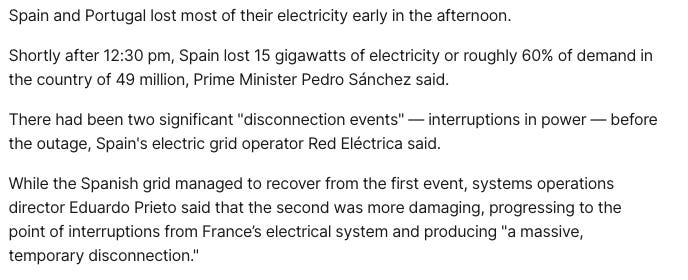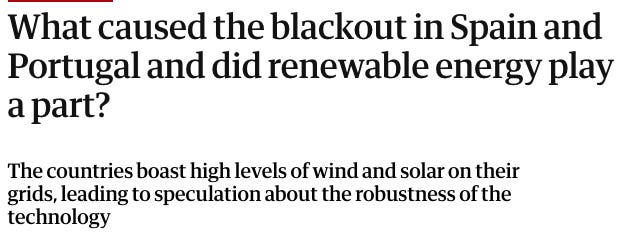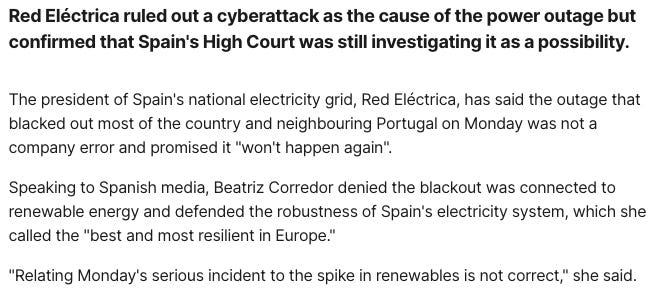Europe’s Great Blackout of 2025
Trillions for renewables, and still the lights go out. What else in Europe is running on fantasy...and how exposed is your capital?
“If you’re wondering whether the people in charge know what they’re doing… just look at the lights.” - The guy fumbling with a flashlight in Madrid, April 28, 2025
If a region builds its entire energy policy on the hope that the sun will shine and the wind will blow, it had better not count on having power when it actually matters.
Welcome to Europe, 2025.
It’s late April. Tourists are sipping café con leche under a blue Iberian sky. And then…click…nothing. No hum. No flicker. Just silence.
Within minutes, that silence turned into the dull roar of chaos.
Hospitals scrambled to backup power. Elevators stalled mid-floor. ATMs went blank. Lights out in southern France, Portugal, and most of Spain.
Tens of millions stranded in what’s now being called the largest blackout in European history.
Nineteen hours of darkness. Eight dead. One 77-year-old man on a ventilator, gone. Carbon monoxide poisoning cases. Mass confusion.
But this isn't just a power outage. It’s a flashing red warning light from the future.
A live-fire demonstration of what happens when political fantasy collides with electrical reality. And guess what?
It’s far from over.
“Extreme Atmospheric Oscillations”
Let’s start with the official story.
According to Spain’s Red Eléctrica (REE), there were “two incidents” in the solar-heavy southwest. Then the connection to France was severed. Then the grid collapsed.

Portugal’s REN said the whole mess began in Spain. France barely shrugged. "Ours were brief," they smirked. Nothing to see here.
An early theory pointed fingers at a “rare atmospheric phenomenon” that caused “oscillations” in high-voltage transmission lines. Sounds fancy…until REN denied ever saying it.
Weather reports? Sunny. Calm. Barely a breeze.
Cyberattack? Ruled out by politicians before the investigation even began.
Translation: nobody knows what happened… but they’re sure it’s not their fault.
Classic.
Of course, blaming the weather is the oldest trick in the bureaucrat playbook. But the real storm wasn’t in the sky…it was in the grid.
And once you start pulling that thread, you realize this blackout wasn’t caused by chaos. It was caused by design.
The Real Culprit: Fragile by Design
Let’s not be coy. This wasn’t a storm. It wasn’t sabotage. It was systemic failure.
Spain and Portugal, poster children of Europe’s net-zero zealotry, have been racing to load their grid with solar and wind.
On paper, they’re winning. On April 28, 80% of Iberia’s electricity came from renewables.
In practice, they were standing on a house of cards.
Solar and wind are volatile. They don’t provide grid inertia. They don’t stabilize frequency. They don’t “hold the line” when a disturbance hits.
That day, Spain was supplying 32 GW for a demand of 25 GW…until it wasn’t. In five seconds, 15 GW vanished. Poof. Gone.
“Total zero,” REE called it. As in: lights out. Game over.
No nuclear backup. No spinning reserves. Just an overloaded grid, humming with unstable electrons until it couldn’t anymore.
The grid failed, not in spite of the renewables…but because of them.
And here’s the uncomfortable truth: the more “green” Europe gets, the less stable it becomes.
What if the very policies meant to future-proof the continent are actually laying the groundwork for systemic collapse?
The next section pulls back the curtain on the infrastructure failures nobody wants to talk about…
Outdated Hardware, Overloaded Dreams
Why did this happen?
Because Europe built a 21st-century fantasy on a 20th-century foundation.
Grid infrastructure? Neglected. Interconnections? Weak. Spain is supposed to be linked to France and Morocco with 15% cross-border capacity. In reality? More like 5%.
The grid was saturated, fragile, and dependent on conditions it couldn’t control. When something went wrong…and something always does…it didn’t bend. It broke.
Sound familiar?
It should. This is what a top-heavy system looks like when it collapses.
And Europe is just getting started.
It wasn’t a lack of ambition that brought the lights down…it was a surplus of fantasy.
But while politicians keep dreaming, someone is cashing the checks. Let’s follow the money…
The Green Grift
Behind every lofty green promise is a money trail. And this one runs straight from Brussels to the bottom lines of a few very well-connected companies.
Iberdrola, Enel, and other energy titans are gorging on subsidies. Billions have been shoveled into solar and wind.
Meanwhile, taxpayers pick up the tab for the grid upgrades that never seem to arrive.
Spain’s REE, 20% state-owned, promised a “resilient” system. Post-blackout? They quietly admitted it’ll take trillions more to make that promise real.
Europe’s Emissions Trading Scheme…supposedly an elegant carbon tax—has become a casino for financial middlemen. Prices whipsaw. Permits profit. Consumers pay.
And as solar flooded the grid with unwanted megawatts, Spain briefly saw negative energy prices. That’s right…too much “clean” electricity, and nowhere to send it.
Except… out the door.
Europeans are being sold energy salvation… at premium prices.
But who really benefits when the grid fails and the cash flows?
To understand that, we need to talk about the political theater…and the scapegoats.
“It Wasn’t Renewables”
The politicians reacted as they always do: with deflection and doublethink.
Spanish PM Pedro Sánchez refused to blame renewables. Opposition leaders called for a nuclear rethink. Sánchez responded by saying nukes were offline and wouldn’t have helped.
Neat trick…blame nuclear for not saving the day, even though his own government shut them down.
This wasn’t about energy. It was about control.
Europe’s energy policy is a lever. Carbon credits, smart meters, usage caps—tools to shepherd the public toward “acceptable” consumption.
Don’t heat your home. Don’t drive too far. Don’t ask too many questions.
Because if you do, you might start wondering…
Who benefits when the lights go out?
When the narrative doesn’t match reality, scapegoats become policy. And when energy becomes a control mechanism, the blackout is just the beginning.
For investors paying attention, the opportunity is hidden in plain sight…
Global Escape Routes: Ten Themes for When the Lights Go Out
Europe’s April blackout didn’t just trip circuit breakers.
It exposed a continent wired for disaster…built on brittle systems, top-down dogma, and a dangerous faith in magic electrons.
If your capital is stuck inside that mess, consider this your evacuation drill.
This wasn’t just a grid failure. It was a preview. Europe’s technocrats are doubling down, not pivoting. They’re chasing control, not competence. And as they steer into the skid, the smart money is quietly heading for the exits.
Here are ten global themes worth exploring…pockets of value, resilience, and raw reality where investors might still find oxygen while Europe chokes on its own virtue.
Not recommendations. Not financial advice. Just a flashlight in the dark.
1. Chinese Tech
Despised in headlines. Discounted in markets. And quietly, still growing. China’s tech giants are pricing in collapse while expanding their moat across e-commerce, AI, and payments. The West sees risk. Contrarians smell dirt-cheap, margin of safety.
2. Greek Equities
Not all of Europe is doomed. Greece…yes, Greece…is quietly rebuilding. Tourism, shipping, and fiscal reforms have sparked a comeback that few are watching. It’s a rare case of competent policy in a noisy neighborhood. Worth a second glance.
3. Argentina
They say never bet on Argentina. That’s why nobody is. Which is exactly what makes it interesting. A new government, new policies, and still dirt-cheap assets. For investors with iron stomachs, the upside could be volcanic.
4. Global Shipping
The world still runs on ships, no matter what Brussels says. As trade reroutes and global supply chains de-fragment, shipping stands to benefit. Meanwhile, ESG has scared away capital. More tonnage, less competition, higher rates.
5. Offshore Oil & Gas
Neglected, hated, essential. Offshore exploration is picking up while public markets ignore it. Demand is rising, supply is capital-starved, and valuations are stuck in 2020. This one screams asymmetry.
6. Uranium
Europe hates it. Asia doesn’t. America is warming up. A global pivot back to nuclear means uranium demand could outstrip supply. There are only so many miners. When the music starts, you’ll want a seat.
7. Physical Gold
In a world of fiat fantasy, gold is gravity. It doesn’t promise yield. It doesn’t need a charging port. It just sits there…quietly reminding central banks what real money feels like. As currencies wobble, gold shines.
8. Coal
Still powers more than a third of global electricity. Still dirt cheap. Still demonized. While Europe pretends it can live without it, the rest of the world buys more. This isn’t ESG. This is energy.
9. Agricultural Assets
People need food. Fertilizer, farmland, and agtech firms are seeing a secular shift as supply chains strain and inflation bites. Unlike European grids, you can’t virtue-signal your way out of a harvest.
10. Natural Gas
Flexible. Transportable. In demand. While Europe gambles on sunshine, other regions are locking in LNG contracts and building infrastructure. U.S. producers stand to benefit as the world reshuffles its energy diet.
Don’t Bet on Broken Systems
Europe’s blackout was a metaphor with a body count.
A warning wrapped in darkness. The continent’s elites won’t change course…they’ll change definitions. They’ll call it a “resilience test.” They’ll blame the weather. They’ll fund another study.
You don’t have to play along.
There are markets where physics still matters. Where capital follows competence.
Where resilience trumps ritual. And where your investments won’t vanish the moment the wind stops blowing.
You can stay and pick through the rubble. Or you can flip the breaker… and walk toward the light.
Your move.
⭐️ Need to build a portfolio? Need the stock picks we are investing in? Need help? Then you need a full Insider Membership…
The Bigger Picture: When Magic Stops Working
Europe thought it could outvote physics. It can’t.
Solar and wind have a role. But building an entire energy system around them—and removing nuclear and fossil fuels before replacements are viable—isn’t just foolish. It’s dangerous.
The elites sold the public a dream: net-zero paradise with clean skies and endless power.
Instead, the dream ends with emergency generators and flickering ICU monitors.
This is the part where the curtain gets pulled back.
The grid wasn’t “resilient.” It was brittle.
The policies weren’t “green.” They were a subsidy slush fund.
And the leaders?
They weren’t leading.
They were gambling…with your safety, your money, and your lights.
This wasn’t a one-off. It was the first crack in a system that’s being held together by ideology, wishful thinking, and the illusion of control.
So the question isn’t whether it will happen again…it’s when. And whether you’ll be prepared when it does.
What Happens Next?
The post-mortem on April 28 is still underway. The commissions will meet. The panels will publish. The politicians will make speeches.
But unless something changes, the grid will fail again.
And next time, it might last longer. Or spread further. Or happen in the dead of winter, when there’s no sun and no wind…and no easy way out.
Because in the end, this blackout wasn’t an accident.
It was an inevitability.
Let’s just hope someone’s paying attention.
Because if they aren’t?
We’ll all be sitting in the dark.
Again.
🔴 The dollar’s in distress, China’s making moves, and Trump’s tariffs are a symptom...not the cause. Is this the end of U.S. monetary dominance? Let’s dig in.






You likely receive hundreds of pitches.
This isn’t one of them.
Hello @Capitalist Exploits,
Respect your work and what you hsve built here.
I am the Founder and Steward of the 100x Farm.
The 100x Farm is a quiet strategy sanctuary for investors and capital stewards with long memories and longer horizons.
No noise. No dopamine. No trend-chasing.
Just deep-cycle clarity earned slowly, shared rarely.
We don’t believe in inbox conquest.
But if the idea of sowing $10,000 seeds to harvest $1 million trees over 20- 30 years feels familiar,
you and your patrons may already belong here.
What if the next 100x isn’t a stock but a forgotten business model hiding in plain sight?
Every thesis is backed by real capital, filtered through over 100 long-cycle lenses before it earns a word.
And if nothing else, this may help you filter what isn’t worth your time.
No urgency. No ask.
Only signal.
Should you, or your patrons, choose to engage, our farm door remains open.
Warmly,
The 100x Farmer